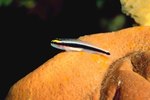The clown knife fish (Chitala ornata) is a freshwater fish indigenous to tropical regions of Asia in river basins and lakes of Indochina, Thailand, Laos, Vietnam, Mekong, Chao Phraya, and Cambodia. Though not indigenous to the United States, the species has been found off the coast of Florida, possibly released by humans. The clown knife fish's unique body structure gives it its name and unique appearance.
Appearance
The clown knife fish is a long, narrow fish that reaches about 40 inches in length in adulthood. It is silver in color, and has several circular markings on its mid-body that become more defined as it matures. Its unique body shape sets it apart from other fish. The clown knife fish's back almost appears like a hump above its small head, which looks like an indentation about its eyes. However, this fish's most distinguishing feature, and the one that gives it its name, is the long, single fin that combines the caudal and anal fin.
Natural Habitat and Behavior
In its natural habitat, the clown knife fish is found in lakes and river basins in tropical regions where the water temperature ranges from around 75 to 82 degrees Fahrenheit. The large fish prefers to dwell in areas around large objects, like rocks, caves and wood, and within vegetation. These areas also are suitable for the species's desire to hide and hunt for food. The clown knife fish also prefers cover during mating and spawning. This species prefers waters in tree-covered areas where it is active in the dark and at night.
Diet
This carnivorous fish is an aggressive hunter of smaller fish, insects, shellfish and crustaceans. Because of its nocturnal nature, most clown knife fish will not eat during the day, and prefer to hunt in the cover of night and among vegetation.
Reproduction
Clown knife fish hide among thick vegetation during the mating process. When spawning, the female searches for rocky substrate to lay her eggs. Until the fry have hatched after an incubation period of about one week, it is common for the male clown knife fish to guard and protect the fragile eggs.
In Captivity
Though large and aggressive in nature, many aquarium enthusiasts who favor larger fish keep clown knife fish as pets. However, a large aquarium is a must for this sizable fish. In captivity, these fish must have plenty of vegetation and hiding places in their tanks, along with rocky substrate for spawning if reproduction is the goal. However, they are difficult fish to breed in captivity because of their size and aggressive tendencies towards other fish (they will tend to turn smaller tank mates into dinner), including mating males and females. When kept as pets, a diet of frozen and whole fish and pellets fed at night will provide the nutrients clown knife fish need to thrive.
References
Writer Bio
Jennifer Lynn has been writing as a correspondent and reporter since 1991. She has written for numerous newspapers and currently writes as a correspondent for Gannett. Lynn has a Bachelor of Arts with a focus on English from Ohio University, where she also studied journalism at the E.W. Scripps School of Journalism.




